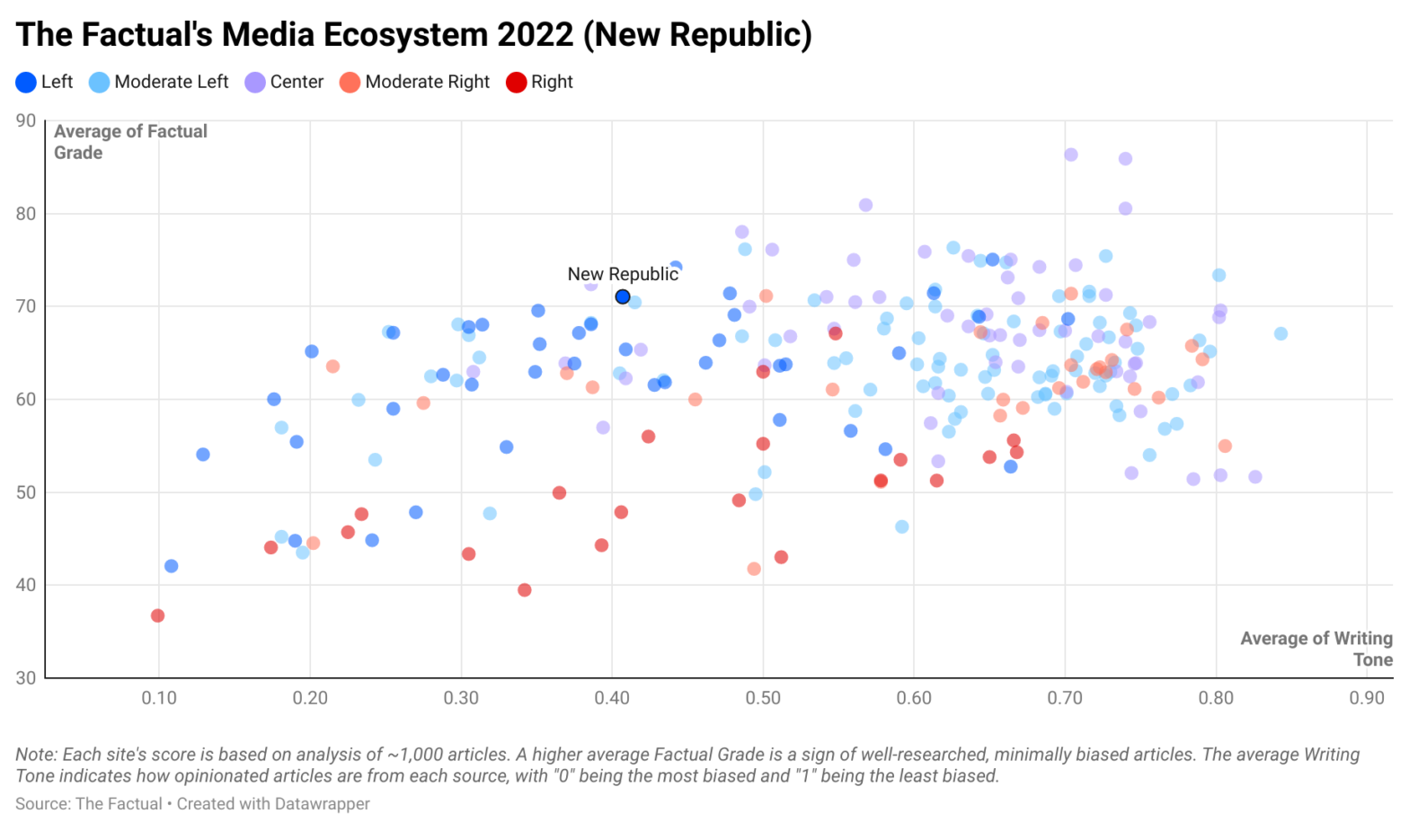The New Republic was founded in 1914 “as an intellectual call to arms for public-minded intellectuals advocating liberal reform in a new industrial age.” Today, it continues to try to carry on that same mission, including to “rethink outworn assumptions and political superstitions as radically changing conditions demand.” As a staunchly progressive publication, the New Republic puts issues like universal health care and climate change front and center (the climate section appears under the banner “Apocalypse Soon”). In light of this strong editorial approach, how biased is the New Republic and how reliable is its news content?
How Does The Factual Rate News Sources?
The Factual analyzes more than 10,000 news stories every day to help readers find the most informative, least-biased articles. Our news-rating algorithm scores each article along four metrics: (1) cited sources and quotes, (2) publication history, (3) writing tone, and (4) author expertise. These scores combine in a weighted average we call a Factual Grade, which ranges from 0–100%. (See our How It Works page to learn more about our algorithm.)
For this study, we analyzed ~1,000 articles each from 240 news sources. The average Factual Grade for the entire dataset was 62.5%. Based on these averages, we can compare the performance of news sites across the media ecosystem. The entire dataset can be explored in greater detail here.
How Factual Is the New Republic?
The New Republic scored an average Factual Grade of 71.1%, placing it in the 87th percentile of our dataset. These high scores are due to strong performance in terms of author expertise and cited evidence. For example, the site has many longtime contributors who routinely cover the same topics, indicating that these journalists are likely to have relevant topical knowledge. Likewise, our scores show that articles on the site are typically accompanied by extensive evidence — including direct quotes and links to external sources — which suggests stories are typically well researched. However, articles tend incorporate biased or opinionated language (see below).
Like any news source, scores for articles from the New Republic varied widely based on factors like author expertise and cited evidence. For example, some scored above 90%, while others scored below 50%.
Please check your email for instructions to ensure that the newsletter arrives in your inbox tomorrow.
How Opinionated Is the New Republic?
One of the metrics The Factual uses is the Writing Tone, which measures how opinionated the writing is in an article. For this metric, the algorithm looks for signs of subjective commentary (e.g., first person pronouns and unnecessary adverbs), as well as the emotional nature of selected words, and sees how prevalent they are for a given length of text. More neutral text receives higher ratings, with “0” being the most opinionated and “1” being the most neutral.
The New Republic had an average Writing Tone score of 0.41, placing it in the 22nd percentile in our dataset. This suggests that articles from the magazine frequently use highly biased or opinionated language. This means articles from the site rarely try to convey information in a neutral manner and may have strongly biased titles, such as “Democrats, Stop Negotiating With Traitors.”
What Is the New Republic’s Political Bias?
The Factual classifies news sites by political bias as either Left, Moderate Left, Center, Moderate Right, or Right. This classification comes from third-party assessments from media bias organizations such as AllSides and Media Bias/Fact Check. Based on this data, The Factual assigns the New Republic a “Left” bias.
Media Bias/Fact Check (MBFC) rates the New Republic as “Left,” due to “story selection and editorial positions” that favor the left. Sources in this category tend to “utilize strong loaded words … publish misleading reports, and omit information” that may damage liberal causes. However, they note that the New Republic has a “High” score for factual reporting and has not failed any fact checks. MBFC points to the website’s About page, which states that the publication has “championed progressive ideas and challenged popular opinion,” which makes the left-leaning classification uncontroversial.
AllSides also classifies the New Republic as “Left,” though it has yet to complete an extensive review of the publication. This classification is based on independent research and 2,730 community ratings. This limited study of the site’s bias is likely an indication that its left-leaning classification is easily defensible.
Who Owns the New Republic?
The New Republic has had many owners over its history but has consistently leaned toward progressive causes and perspectives. Today, the New Republic is owned by Oregon-based publisher and editor Win McCormack. McCormack co-founded the progressive liberal magazine Mother Jones and has worked extensively for Democratic causes in Oregon. Facebook co-founder Chris Hughes owned the magazine from 2012 to 2016, in what the New York Times described as a “vanity project.” His attempts to change the magazine into a vertically integrated digital media company, and temper some partisan stances, instead resulted in the resignation of many longtime staff. The magazine is funded through subscriptions and advertising.
Please check your email for instructions to ensure that the newsletter arrives in your inbox tomorrow.
Why Does It Matter?
News articles always have some bias because all authors have some frame of reference within which they describe a story. Political bias ratings are helpful in understanding this framing. However, it can be more beneficial to know how factual an article is based on quantifiable metrics that can be seen across the media ecosystem, such as cited evidence, author expertise, and writing tone. This is what The Factual ascertains.
Reading several, highly rated articles from across the political spectrum helps counter the bias of any news source or story. To have the day’s most factual news stories delivered to your inbox every morning, subscribe to our daily newsletter.
This article was updated on September 21, 2021 to reflect new data.

